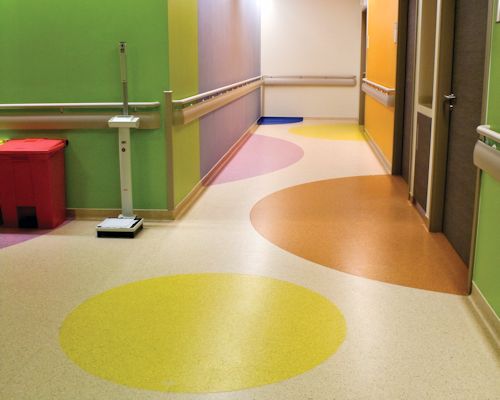 Audio for slide 3 (mp3)
Audio for slide 3 (mp3)
The word linoleum comes from 'linum' (Latin for flax) and 'oleum' (meaning oil). It was first invented in the 1850s, using oxidised linseed oil, cork dust and gum to form a resinous mixture, which was poured onto a cotton cloth backing. Although there have been many refinements to the manufacturing process over the last 160 years, the basic principles haven't changed. The main reason linoleum is still so popular is due to its long-term durability and wide range of colours. It is also highly resistant to scratching and performs very well in high traffic areas.
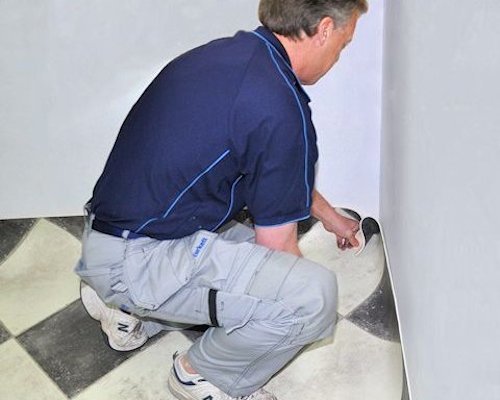 Audio for slide 4 (mp3)
Audio for slide 4 (mp3)
Before you undertake this unit The content material in this unit follows on from the topics covered in the following two units: Commercial vinyl Lay flat vinyl. If you haven't already completed these units, you should go to them now and read up on general techniques of installing resilient sheet products, along with the discussions on safety, adhesives and tools.
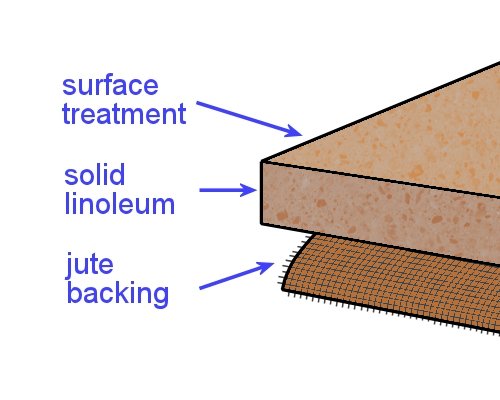 Audio for slide 6 (mp3)
Audio for slide 6 (mp3)
Linoleum is made from natural materials. The primary ingredients are linseed oil and rosin (tree resin). These are mixed with other substances, such as wood flour, limestone powder and colour pigments, to form 'linoleum granulates'. The granulates are pressed onto a hessian backing in a rolling mill to make the linoleum sheet. Hessian is a fabric that's woven from jute plant fibres.
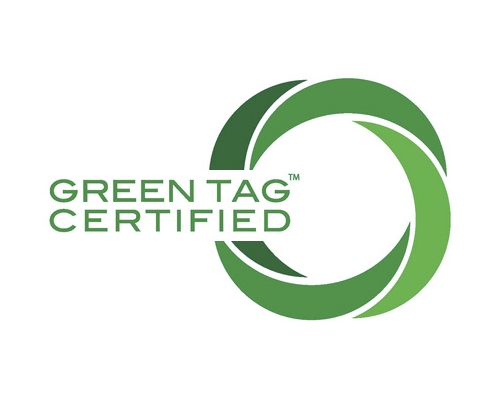 Audio for slide 7 (mp3)
Audio for slide 7 (mp3)
Given the fact that all of these materials are naturally occurring and biodegradable, linoleum is often considered to be more environmentally friendly than vinyl flooring. Having said that, it is true that vinyl manufacture requires less power - so there are less greenhouse gasses emitted while it is being made. It's also the case that recycled PVC flooring is increasingly being used as a base material in the manufacture of new vinyl products.
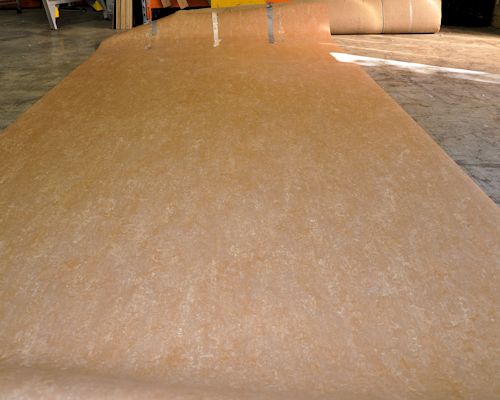 Audio for slide 8 (mp3)
Audio for slide 8 (mp3)
Drying room yellowing Because linoleum uses linseed oil as one of its ingredients, it sometimes develops an appearance on the surface called 'drying room yellowing'. The yellowing occurs when the linseed oil oxidises while it's drying. Its final effect depends on the colours in the linoleum - for example, blues and greens tend to look greener, and beige takes on a yellowish hue.
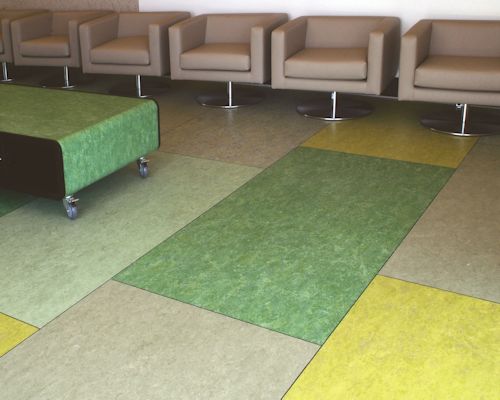 Audio for slide 9 (mp3)
Audio for slide 9 (mp3)
Once the flooring is exposed to light, the yellowing disappears. In bright sunlight, this process will take only a few hours; but in artificial light it can take up to several weeks. Nonetheless, it will still disappear in time, even if you put a floor finish or polish over the yellowing. If furniture or other objects are placed on the linoleum and the light is blocked out, the yellowing cast may start to reappear. However, you can reassure the client that this isn't a stain. Once it's exposed to light, it will fade away again.
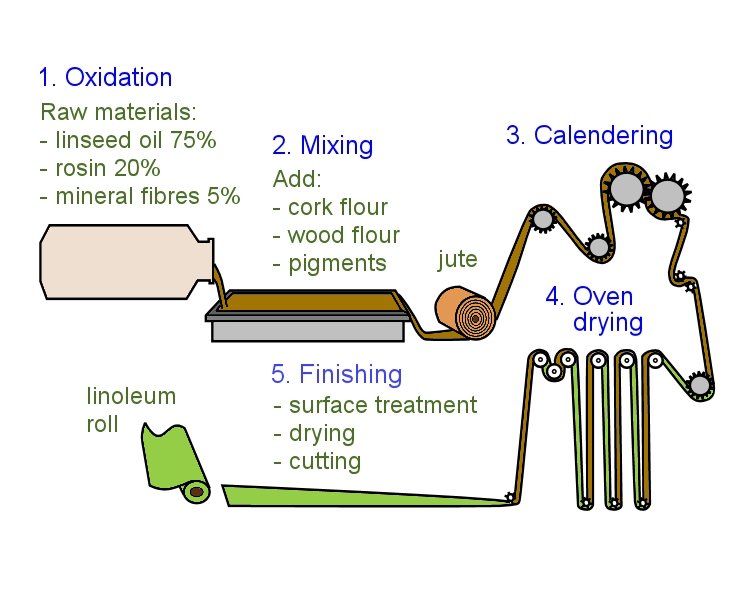 Audio for slide 10 (mp3)
Audio for slide 10 (mp3)
Manufacturing process This diagram shows the process used to manufacture linoleum sheet flooring. It has been adapted from a drawing developed by Tarkett.
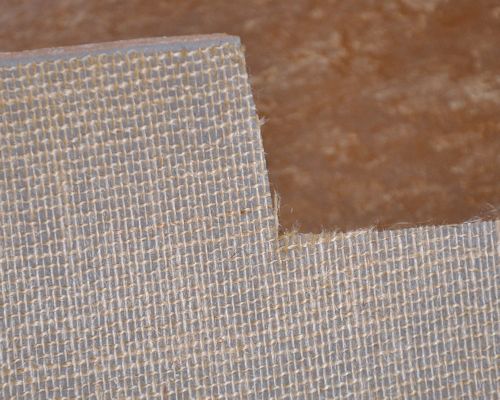 Audio for slide 12 (mp3)
Audio for slide 12 (mp3)
The basic techniques for cutting, fitting and welding linoleum are much the same as for commercial vinyl. However, linoleum has slightly different properties from vinyl, so there are a few important differences.
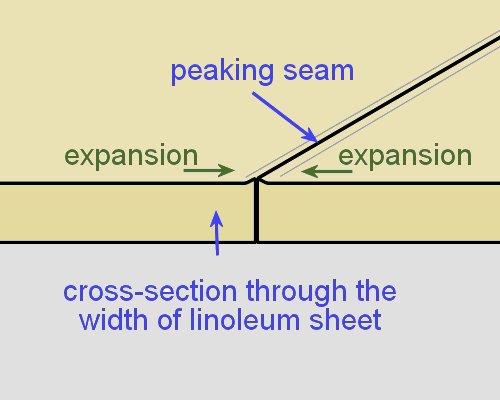 Audio for slide 13 (mp3)
Audio for slide 13 (mp3)
Cutting seams When linoleum is rolled out and placed into the adhesive, the hessian-backed material picks up moisture from the atmosphere and adhesive. This causes a small amount of expansion across the width of the sheet, which stops when the adhesive starts to cure. Even though the expansion is only tiny, it can cause the seam to peak if you don't make allowance for it.
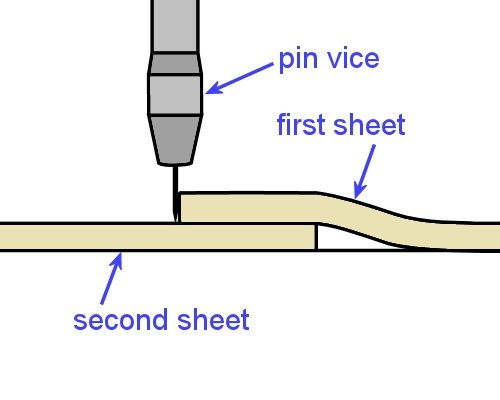 Audio for slide 14 (mp3)
Audio for slide 14 (mp3)
The allowance only needs to be about the thickness of the pin in a pin vice. You can accommodate any expansion by using the following procedure: Cut the true edge in the first sheet of linoleum as you would for commercial vinyl. Lap the second sheet under the first sheet, either matching up the pattern or leaving a 20 mm overlap.
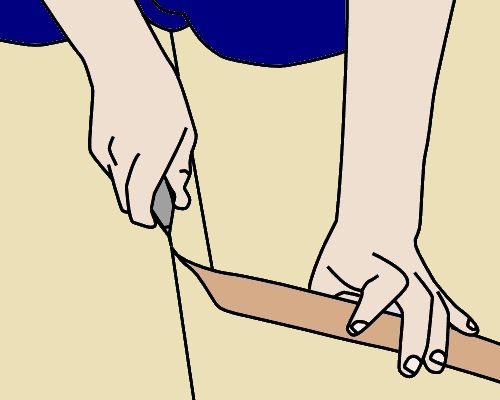 Audio for slide 15 (mp3)
Audio for slide 15 (mp3)
Score the second sheet with a pin vice, keeping the pin vertical and pressed against the true edge of the first sheet. Cut the second sheet with a straight blade and hooked blade.
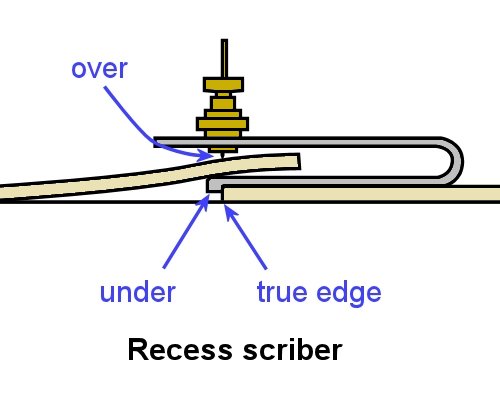 Audio for slide 16 (mp3)
Audio for slide 16 (mp3)
Alternatively, you can use a recess scriber to scribe the second sheet. Run the 'under' guide along the true edge of the first sheet and scribe the second sheet with the 'over' scribe pin. But remember to offset the scribe pin by the thickness of the pin to achieve the same result as described before.
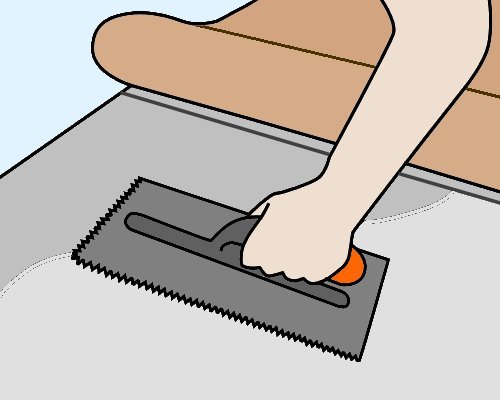 Audio for slide 17 (mp3)
Audio for slide 17 (mp3)
Fitting long lengths If the sheet is long, it will tend to shrink slightly along the length, so you need to make allowance for the shrinkage when you cut the sheet. One method of dealing with the shrinkage is to only scribe one end and stick down the sheet up to about the last 2 metres. Then scribe the second end, spread the remaining adhesive and stick that end down. Note that the whole sheet must be stuck down while the adhesive is still wet. If the first part starts to set before you lay down the last section, any overspread in adhesive might result in bubbles where the two parts meet.
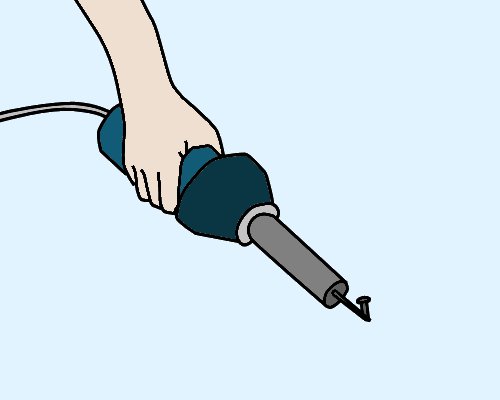 Audio for slide 18 (mp3)
Audio for slide 18 (mp3)
Heat welding Welded joins are less necessary in linoleum than in vinyl, because well-cut seams are more likely to close up tightly after the material has been stuck down. However, if hygiene or water resistance are important aspects of the job, you should still weld all joins.
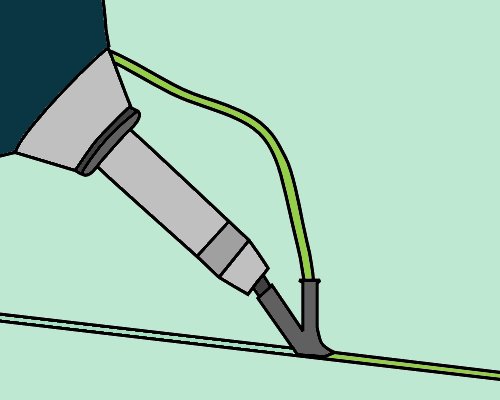 Audio for slide 19 (mp3)
Audio for slide 19 (mp3)
The tools used for heat welding are the same for both vinyl and linoleum. However, the welding cable is different, and linoleum is welded at a lower temperature and slower speed. The chemical reaction that occurs in the welded joint is also different. In vinyl, both the flooring material and welding cable melt and fuse together; but in linoleum, only the cable melts as it bonds to the routed seam.
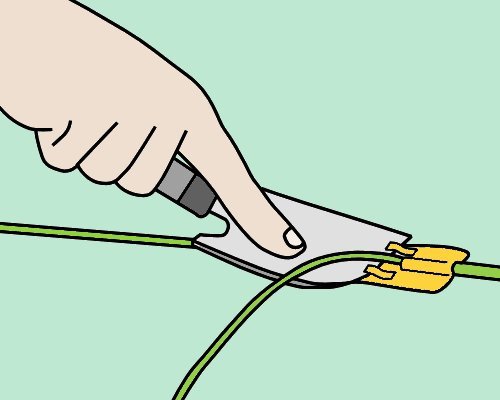 Audio for slide 20 (mp3)
Audio for slide 20 (mp3)
Linoleum welds should be trimmed almost immediately for the first pass, and soon after for the second. This is different from vinyl, where you should wait a bit longer before doing the first pass, and then let it completely cool before the second pass.
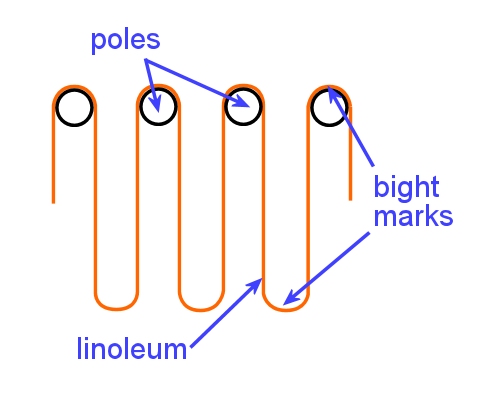 Audio for slide 22 (mp3)
Audio for slide 22 (mp3)
Bight marks occur in linoleum where a continuous sheet loops over poles in the drying oven while it's curing. The bight marks at the top are cut out at the factory and the discarded material is recycled. However, the marks at the bottom of each loop are left in the sheet. In the finished roll they often appear as a slight ridge across the sheet, about 150 mm wide.
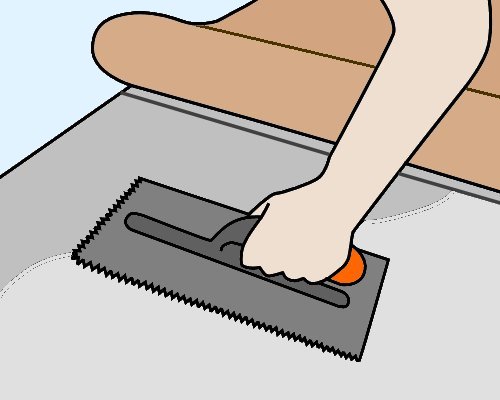 Audio for slide 23 (mp3)
Audio for slide 23 (mp3)
With products that are 2.0 to 2.5 mm thick, the ridge can be stuck down in the normal way as long as the site is warm and the bight mark is well rolled both across and then along the sheet.
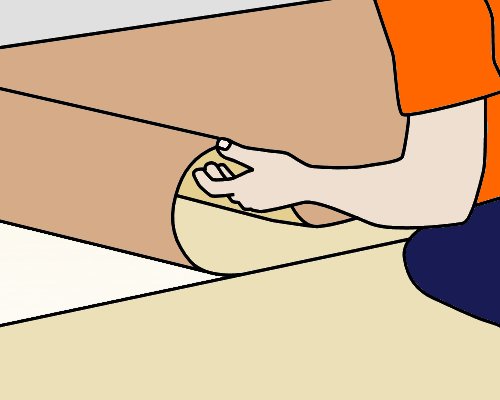 Audio for slide 24 (mp3)
Audio for slide 24 (mp3)
But with 3.2 mm material, or if the temperature is cool, you may need to either cut out the bight mark or use the following technique: As you feed the sheet into the wet adhesive and reach the bight mark, lean gently on the mark and rock it in and out of the adhesive, making sure there is a complete transfer of adhesive onto the hessian backing.
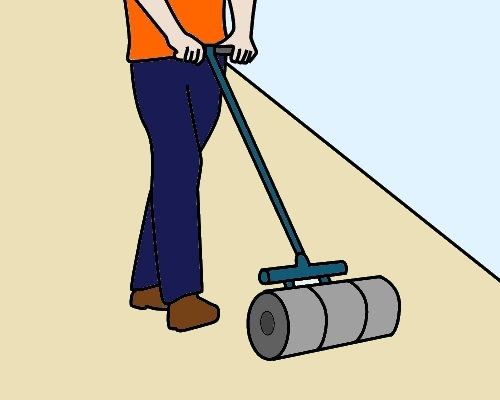 Audio for slide 25 (mp3)
Audio for slide 25 (mp3)
When the loop of material being fed into the adhesive clears the area of the bight mark, immediately roll it with a 68 kilogram roller and remove any bubbles or trapped air. Continue to roll the bight mark every 15 minutes until it has fully bonded to the subfloor. An alternative method is to use contact adhesive on the subfloor where the bight mark falls. For more information on this process, see the Forbo Floorcoverings Installation Guide'
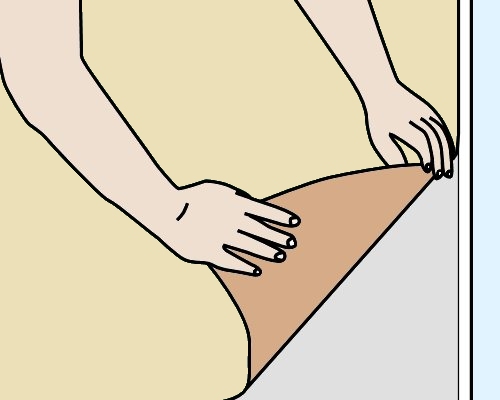 Audio for slide 26 (mp3)
Audio for slide 26 (mp3)
Removing end curl The end of the linoleum sheet also needs to be laid carefully, to make sure that the hessian backing beds well into the adhesive. If you fold the corner back diagonally and use a 'bouncing' action as you place it into the adhesive, it will help to relieve the tension in the end of the length. Then roll the sheet thoroughly with a floor roller.
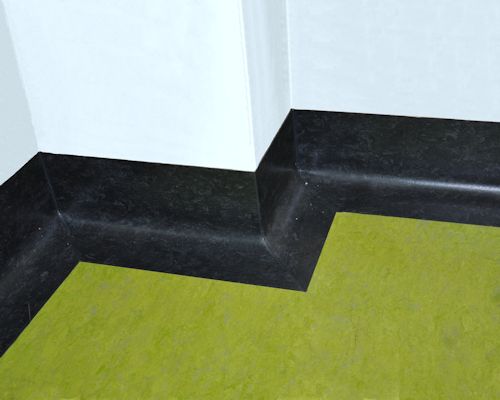 Audio for slide 28 (mp3)
Audio for slide 28 (mp3)
Coving in linoleum is generally installed as a border cove, with a separate piece joined at the floor to the field material. It can either be the same colour as the field material or in a contrasting feature colour. Border coving can be formed on-site from field material or installed as preformed pieces.
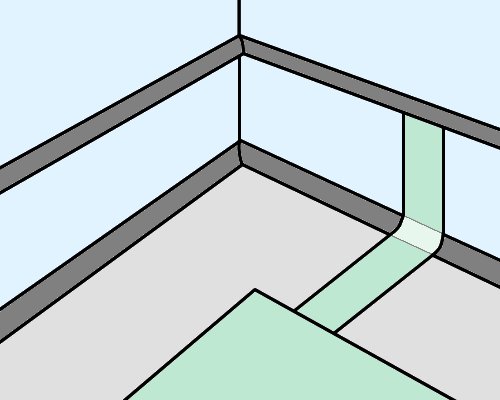 Audio for slide 29 (mp3)
Audio for slide 29 (mp3)
Using field material to form a border cove Lay the field material first. Draw a line on the wall to mark the top of the coving. Fit a capping strip and the cove former using contact adhesive. Measure the full width of the cove and border using a flexible ruler or a scrap piece of material.
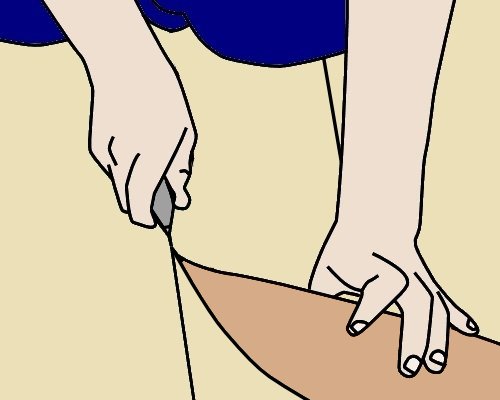 Audio for slide 30 (mp3)
Audio for slide 30 (mp3)
Cut strips of the correct size from the roll of flooring material. Note that the strips should be cut lengthwise - if you cut across the end of the roll, the piece is likely to curl inwards in the opposite direction from the way you want to turn it for the cove. Butt join each strip against the field material and check that it sits correctly.
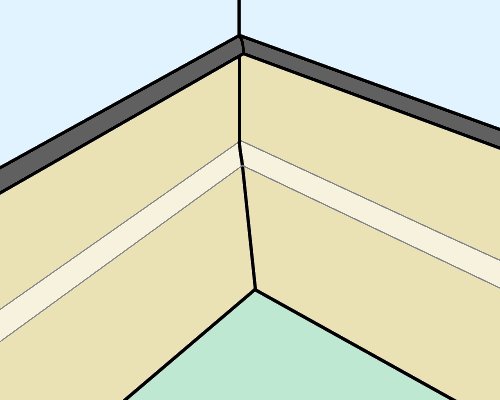 Audio for slide 31 (mp3)
Audio for slide 31 (mp3)
Spread the adhesive and wait the required time. Warm the linoleum with a heat gun to make it easier to curve the material over the cove fillet. Carefully place the linoleum into position. Ease the top edge into the capping strip with a screwdriver.
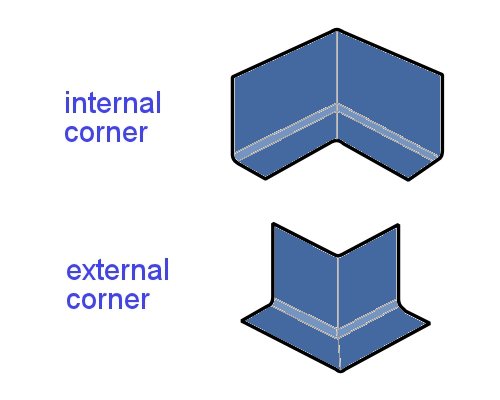 Audio for slide 32 (mp3)
Audio for slide 32 (mp3)
Installing preformed pieces Some manufacturers produce preformed border coving with a reinforced backing. This is supplied in long straight lengths and cut or mitred with a saw on-site. There are also preformed internal and external corners, which can be used as an alternative to mitre cutting the long lengths. These pieces are placed in position on the floor and heat welded to the adjoining pieces.





